
Nestled in the heart of Sicily, far from the well-trodden coastal paths and bustling cities, lies Caltanissetta, a city steeped in ancient heritage, noble traditions, and a rustic charm that offers a truly authentic Sicilian experience. Often overlooked by mainstream tourism, Caltanissetta is a treasure trove of culture, architecture, folklore, and cuisine, all surrounded by the rolling hills of central Sicily.
This is a place where aristocratic palaces coexist with Baroque churches, where ancient sulfur mines speak of industrial history, and where Holy Week celebrations rival those of Seville. Caltanissetta might not have the instant name recognition of Palermo or Taormina, but those who make the journey discover a captivating world untouched by mass tourism.
The city’s name is believed to derive from the Arabic “Qalʿat al-Nisāʾ”, meaning *Castle of the Women*, a name that hints at the city's multicultural past. Like much of Sicily, Caltanissetta has seen layers of civilizations rise and fall, Greek, Roman, Byzantine, Arab, Norman, and Spanish influences all left their mark.
Despite its central inland position, Caltanissetta was once a vital strategic and economic hub, particularly during the 19th and early 20th centuries, when it became one of the largest sulfur producers in the world. The mining industry brought economic growth and cultural exchange, and its echoes are still felt in the region’s identity today.
Walking through Caltanissetta’s historic center, you’ll discover a wealth of elegant architecture, a blend of Baroque, Neoclassical, and 19th-century styles:
Palazzo Moncada: A 17th-century noble palace with intricately carved stone façades. Though partially in ruins, its grandeur evokes the city’s aristocratic past.
Palazzo del Carmine: Now the Town Hall, this Neoclassical building opens onto Piazza Garibaldi, the city’s vibrant heart.
Cathedral of Santa Maria La Nova: Built in the 16th century and richly decorated with frescoes by Flemish painter Guglielmo Borremans, this church is an artistic gem.
The Via Berengario Gaetani and surrounding alleys are filled with small cafés, family-run pasticcerie, and traditional shops that preserve the city’s enduring identity.
Caltanissetta is famous throughout Sicily for its deeply emotional and theatrical Holy Week (Settimana Santa) processions. Dating back to the 17th century, these events blend sacred devotion with stunning artistry and are central to the city’s cultural fabric.
La Real Maestranza: The most iconic of the processions, held on Holy Wednesday, features men dressed in historic Spanish-style uniforms carrying religious statues through the streets.
Vare processions: On Good Friday, large sculptural groups representing the Passion of Christ, some carved in wood and dating back centuries, are paraded in solemn silence.These traditions, handed down through generations, offer an unforgettable window into the soul of Sicilian Catholicism and communal identity.
In the 19th and early 20th centuries, Caltanissetta was a global sulfur powerhouse, supplying the essential mineral for the production of gunpowder and industrial chemicals. Thousands of miners worked in tough, dangerous conditions deep underground.
Today, the legacy of this era is preserved at the Museo Mineralogico e Paleontologico della Zolfara (Sulfur Mine Museum), housed in the former Trabonella mine site. The museum offers visitors an immersive look at the mining industry, complete with tools, machinery, and personal stories of the miners, some of them children known as *carusi*, whose plight drew international attention.
Despite its historic roots, Caltanissetta is very much a living city. Its neighborhoods blend the old with the new, offering visitors a chance to engage with local life:
Monastery of San Domenico: A peaceful space for reflection, with Baroque altars and cloisters.
Teatro Regina Margherita: A beautifully restored 19th-century theater that hosts concerts, operas, and plays.
Sant’Agata al Collegio: A Jesuit church with an impressive dome and richly detailed interior.
The Mercato Storico (Historic Market) is a feast for the senses. Here you’ll find fresh cheeses, olives, sun-dried tomatoes, wild fennel, and handmade pastries like pignolata and torrone nisseno. Don’t miss a chance to try cavatelli con ricotta, a local pasta specialty, or Sicilian cannoli, which many claim taste better inland than on the coast.
While Caltanissetta isn’t on the sea, it is surrounded by rolling hills, wheat fields, and olive groves. A short drive takes you to:
Monte San Giuliano, offering panoramic views and great walking trails.
Lake Pergusa and Enna, to the northeast, perfect for day trips filled with history and nature.
Piazza Armerina, home to the Roman Villa del Casale with its famous mosaics, just under an hour away.
Caltanissetta may not be glamorous or flashy, but it is deeply authentic. Here, you’ll find a city that wears its soul openly, a place of quiet beauty, strong community, layered history, and meaningful tradition. It's perfect for travelers who want to see Sicily beyond the postcards, away from tourist crowds, and into the heart of the island.
Whether you're captivated by Baroque facades, fascinated by industrial history, or simply want to experience Sicily at its most genuine, Caltanissetta invites you to slow down, explore, and connect. It is Sicily, unfiltered.

More Details



